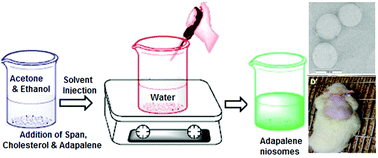Advanced development of a non-ionic surfactant and cholesterol material based niosomal gel formulation for the topical delivery of anti-acne drugs
Abstract
The aim of the present investigation was to develop adapalene (ADP), a high lipophilicity and low solubility anti-acne drug-loaded niosomal topical gel formulation, in order to improve its therapeutic efficacy. ADP niosomes were prepared using Span 60 and cholesterol using a modified ethanol injection method. A design of experiments (DOE) study was conducted to optimize ADP loaded niosomes. The potential of ADP niosomes was investigated for in vitro release and ex vivo skin permeation studies. Additionally, ADP niosomes were loaded into the Carbopol 934 gel and studied for its skin irritation, skin deposition and ex vivo skin permeation potential. The developed ADP niosomes showed the mean particle size, zeta potential, and entrapment efficiency of 278 nm, −17.99 mV, and 86%, respectively. The optimized ADP niosomes showed controlled drug release up to 12 h. Nevertheless, the niosomal gel displayed controlled drug release up to 24 h with a reduction in skin irritation in Wistar rats. An in vivo skin deposition study showed 2.5-fold higher ADP retention in the stratum corneum layer as compared to the commercial ADP formulation. The ADP niosomal gel would be a safe and valuable alternative to the conventional delivery systems for the treatment of acne.



 Please wait while we load your content...
Please wait while we load your content...